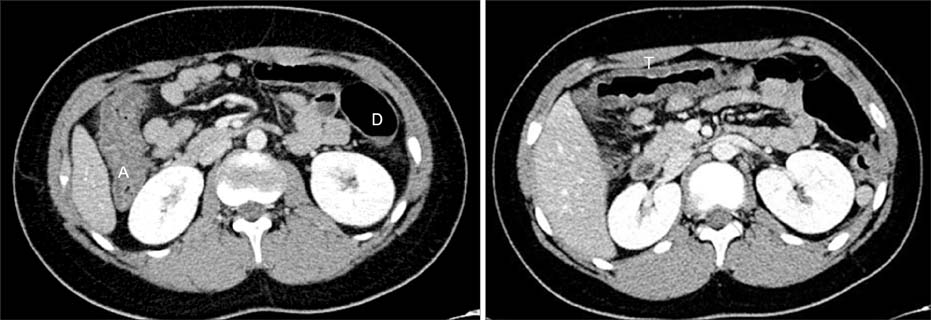Pediatr Gastroenterol Hepatol Nutr.
2018 Apr;21(2):141-146. 10.5223/pghn.2018.21.2.141.
Antibiotics-Associated Hemorrhagic Colitis Caused by Klebsiella oxytoca: Two Case Reports
- Affiliations
-
- 1Department of Pediatrics, Ewha Womans University College of Medicine, Seoul, Korea. jwseo@ewha.ac.kr
- 2Department of Radiology, Ewha Womans University College of Medicine, Seoul, Korea.
- 3Department of Pathology, Ewha Womans University College of Medicine, Seoul, Korea.
- 4Department of Laboratory Medicine, Ewha Womans University College of Medicine, Seoul, Korea.
- KMID: 2409366
- DOI: http://doi.org/10.5223/pghn.2018.21.2.141
Abstract
- Nowadays, Klebsiella oxytoca is described as a causative organism for antibiotic-associated hemorrhagic colitis (AAHC). Here we report two cases of pediatric AAHC, from which K. oxytoca was cultured after starting amoxicillin-clavulanate or amoxicillin treatment. The patients developed severe abdominal pain and a large amount of bloody diarrhea. K. oxytoca was obtained in intestinal fluid culture of a boy through the colonoscopy. On the other hand, colonic tissue culture and intestinal fluid culture were negative of the other patient. K. oxytoca was detected in stool culture when he was admitted. These cases showed characteristic endoscopic findings of segmental hemorrhagic colitis, and both boys recovered spontaneously within 2-3 days after they stopped taking the antibiotics. Therefore, in children who develop relatively large amount of bloody diarrhea after antibiotic treatment, we should consider AAHC caused by K. oxytoca.
MeSH Terms
Figure
Reference
-
1. Bartlett JG. Clinical practice. Antibiotic-associated diarrhea. N Engl J Med. 2002; 346:334–339.2. Toffler RB, Pingoud EG, Burrell MI. Acute colitis related to penicillin and penicillin derivatives. Lancet. 1978; 2:707–709.
Article3. Hoffmann KM, Deutschmann A, Weitzer C, Joainig M, Zechner E, Högenauer C, et al. Antibiotic-associated hemorrhagic colitis caused by cytotoxin-producing Klebsiella oxytoca. Pediatrics. 2010; 125:e960–e963.
Article4. Sakurai Y, Tsuchiya H, Ikegami F, Funatomi T, Takasu S, Uchikoshi T. Acute right-sided hemorrhagic colitis associated with oral administration of ampicillin. Dig Dis Sci. 1979; 24:910–915.
Article5. Beaugerie L, Metz M, Barbut F, Bellaiche G, Bouhnik Y, Raskine L, et al. Klebsiella oxytoca as an agent of antibiotic-associated hemorrhagic colitis. Clin Gastroenterol Hepatol. 2003; 1:370–376.
Article6. Yonei Y, Yoshizaki Y, Tsukada N, Inagaki Y, Miyamoto K, Suzuki O, et al. Microvascular disturbances in the colonic mucosa in antibiotic-associated haemorrhagic colitis: involvement of platelet aggregation. J Gastroenterol Hepatol. 1996; 11:681–685.
Article7. Högenauer C, Langner C, Beubler E, Lippe IT, Schicho R, Gorkiewicz G, et al. Klebsiella oxytoca as a causative organism of antibiotic-associated hemorrhagic colitis. N Engl J Med. 2006; 355:2418–2426.
Article8. Dietrich CF, Lembcke B, Seifert H, Caspary WF, Wehrmann T. Ultrasound diagnosis of penicillin-induced segmental hemorrhagic colitis. Dtsch Med Wochenschr. 2000; 125:755–760.
Article9. Högenauer C, Hinterleitner T. Klebsiella oxytoca as a cause of antibiotic-associated colitis. Washington, DC: ASM Press;2008. p. 293–311.10. Murphy MS. Management of bloody diarrhoea in children in primary care. BMJ. 2008; 336:1010–1015.
Article11. Bellaïche G, Le Pennec MP, Choudat L, Ley G, Slama JL. Value of rectosigmoidoscopy with bacteriological culture of colonic biopsies in the diagnosis of post-antibiotic hemorrhagic colitis related to Klebsiella oxytoca. Gastroenterol Clin Biol. 1997; 21:764–767.12. Youngster I, Avorn J, Belleudi V, Cantarutti A, Díez-Domingo J, Kirchmayer U, et al. Antibiotic use in children-a cross-national analysis of 6 countries. J Pediatr. 2017; 182:239–244.
- Full Text Links
- Actions
-
Cited
- CITED
-
- Close
- Share
- Similar articles
-
- Antibiotics Associated Hemorrhagic Colitis: A report of two cases
- A case of liver abscess due to Klebsiella oxytoca
- Liver Abscess Caused by Klebsiella oxytoca with Hepatic Artery Pseudoaneurysm: A Case Report
- Enteric infections complicating ulcerative colitis
- A Case of Amoxicillin-induced Segmental Hemorrhagic Colitis






